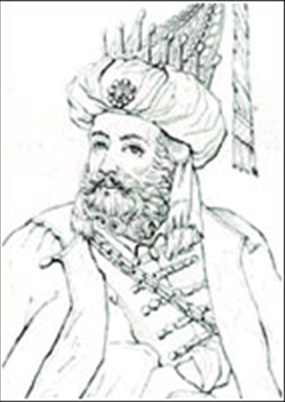Aurangzeb, emperor
| Line 1: | Line 1: | ||
| − | [[File: Aurangzeb.png||frame|500px]] | + | [[File: Aurangzeb.png|Aurangzeb|frame|500px]] |
{| class="wikitable" | {| class="wikitable" | ||
|- | |- | ||
Revision as of 11:56, 1 September 2013
This is a collection of articles archived for the excellence of their content. Readers will be able to edit existing articles and post new articles directly |
Aurangzeb
Chinks in Aurangzeb’s armour
By Mubarak Ali [Dawn Aurangzeb Alamgir, the last great Mughal Emperor, died in 1707. He left a vast empire, which soon began to disintegrate as soon as he passed away because it could not be managed and administered by his successors.
He became a controversial figure in the history of India, especially during the second decade of the 20th century as a result of the emergence of communalism that influenced Indian historiography.
Aurangzeb’s critics condemn him for being an extremist and a fanatic who was responsible for the downfall of the Mughals. His admirers eulogise him for being pious and virtuous, a person of great talent who managed the empire in spite of a number of serious crises.
Though no academic work on his rule has been undertaken in Pakistan, the orthodox circles see him as a model for their ideals of Islamisation while comparing him with Akbar and Dara Shikoh who deviated from Islamic traditions and harmed the interests of the Muslim community in India. After Jadunath Sarkar, there have been a number of books and articles published in India on Aurangzeb to understand his role in Indian history.
According a new research, Aurangzeb should be understood in the context of power politics. He was a pragmatic ruler who pursued his policies and used religion for his political ends. He did not execute his brothers for any political reasons but on religious charges because it suited him. Dara was condemned to death by the council of ulema for being an athiest, while Murad was killed on the basis of qisas. The ulema were under his influence and he would get fatwas from them according to his liking.
For example, during the siege of Satara, four Muslims and nine Hindus were brought as prisoners of war. He asked the qazi about punishment. The qazi issued a fatwa that if Hindu prisoners converted to Islam, they would be freed and Muslims be kept in prison. The emperor did not like this and reprimanded the qazi that there were other schools of jurisprudence besides the Hanafi. The qazi understood what he wanted and issued another fatwa condemning all prisoners to death. On the other hand, when some Sunni nobles asked him to sack Shia nobles from high administrative offices, he refused and told them that religion and politics were two separate things.
Some suggest Aurangzeb demolished Hindu temples in Gujarat, Banaras, Mathura, and Thatta. His supporters justify these acts on the basis that these temples were centres of political intrigue at the time. However, there is no such evidence. As a matter of fact, the demolition was a deviation from Akbar’s policy of sulh-i-kul in which all Mughal subjects were treated on the basis of equality. By demolishing temples he wanted to assert his authority and put an end to the continuity of Akbar’s policies.
But recently, a number of framin have been discovered that were awarded by Aurangzeb to different temples belonging to Hindus, Sikhs, and Jains to maintain them through financial help which was given by the state. In the Deccan region, where he spent the last years of his life, he did not demolish any temple because it was not in his interest to violate religious sentiments of people.
About the imposition of jizya, a historian Satish Chandra argues that he implemented it in 1679, after 22 years of coming to the throne. That was the time when he was in conflict with the Rajputs and rulers of the Deccan states and wanted to get support from the orthodox groups of the Muslim community. However, the officers who were in charge of collecting jizya proved corrupt and inefficient, which is why he abolished it in 1704.
Aurangzeb was an austere man and never indulged in luxury. He abolished taxes which were unIslamic and were a burden on the people. He prohibited music and dance in the court. He personally supervised government functioning. In spite of his piety and frugality, the character of the ruling classes was quite different. Nearly all high officials were corrupt. His generals would receive bribes from the Marathas to unnecessarily prolong the siege of the forts. State officials were unpopular among the people because of their exploitative behaviour. Even Qazi Abdul Wahab was well known for his corruption. Wine drinking and sexual promiscuousness were common among the nobility. Aurangzeb failed to control or reform it.
There were weaknesses in his character. He never trusted anybody, not even his sons. He ruled for 49 years and did not allow his children to get experienced in politics and administration. He also failed to understand the emerging identities of the Rajputs, the Marathas and the Jats who wanted to play an independent role in their territories. He spent 17 years in the Deccan region fighting rulers of South India and exhausted the energies of his empire. His overstay in power overlooked North India, which was then the centre of the empire.
Was Aurangzeb responsible for the downfall of Mughals? He did have his share in the empire’s disintegration, but there were other factors as well.
